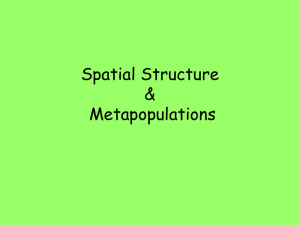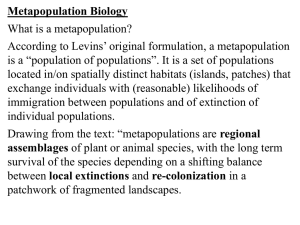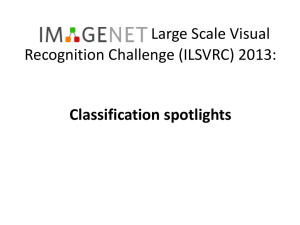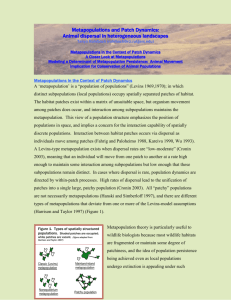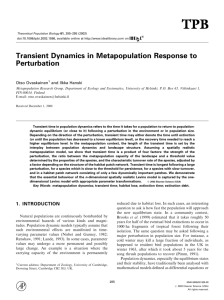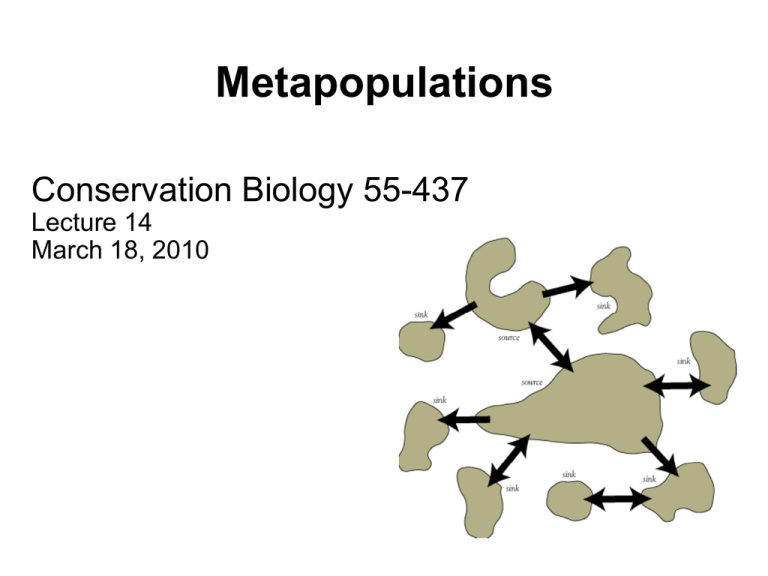
Metapopulations
Conservation Biology 55-437
Lecture 14
March 18, 2010
Populations are subject to demographic processes:
1)Birth
2)Immigration
Increase population size
3)Death
4)Emigration
decrease population size
Populations may be naturally patchily distributed from
variation in resources, physical gradients, or biological
characteristics
In some patches of a given landscape area:
• Recent colonization results in an increasing population size
• In others, populations decline to local extinction
• Others remain unoccupied
Patchily Distributed Populations
Populations may be naturally
patchily distributed from
variation in resources,
physical gradients, or
biological characteristics
In some patches of a given
landscape area:
Natural distribution of different forest
species in the Great Smoky Mountains.
• Recent colonization results
in an increasing population
size
• In others, populations
decline to local extinction
• Others remain unoccupied
Disturbance and heterogeneity
Levins (1969) introduced the
concept of metapopulations to
describe the dynamics of this
patchiness, as a population of
fragmented subpopulations
occupying spatially separate
habitat patches in a fragmented
landscape of unsuitable habitat
Metapopulation structure
Shaded areas provide an excess of individuals which
emigrate to and colonize sink habitats (open).
• A system of populations that is linked by occasional
dispersal (Levins 1969).
Levins, R. 1969. Bull. Ent. Soc. Am. 15:237-240.
Metapopulations
• In metapopulations, each subpopulation is unstable (subject to
random extinction/recolonization.
• Individual subpopulations may
go extinct, though the overall
population persists because
some subpopulations are doing
well while others are performing
poorly.
• Dispersal among patches
assures long term viability.
Overall population
• Persistence of some local
populations (sinks) depends
on some migration from
nearby populations (sources).
• Empty patches susceptible to
colonization.
source
sink
Hanski (1998) proposed 4 conditions before assuming that
metapopulation dynamics explain spp. persistence
Hanski, I. 1998. Nature 396:41−49.
1) Patches should be discrete habitat areas of equal quality
i.e. homogeneous.
2) No single population is large enough to ensure long-term
survival.
3) Patches must be isolated but not to the extent of preventing
re-colonization from adjacent patches.
4) Local population dynamics must be sufficiently
asynchronous that simultaneous extinction of all local
populations is unlikely.
Without 2 & 3: we have a ‘mainland-island’ metapopulation
i.e. persistence depends on supply
from source population, some
fragments may rarely receive or
supply migrants
Levins' Model
Based on patch occupancy modeled as the fraction of
occupied patches (f) at any given time f depends on balance
between rate of extinction e in occupied patches and
recolonization rate of empty patches c. Here, p reflects the
proportion of the population. Thus, extinctions in currently
occupied patches are represented by ep and colonization of
unoccupied patches by cp(1-p).
dp/dt = cp(1-p) - ep
Levin’s Model
Estimating persistence with metapopulation
structure:
dp/dt = cp(1-p) – ep
Here, colonization of patches cp is proportional to the number
of unoccupied patches (1-p):
cp(1-p)
The growth of the population is limited by the availability of
unoccupied patches (1-p).
When p is very small, almost all patches are unoccupied and
available for colonization. Under these circumstances,
colonization rate is ~ cp.
Levin’s Model
Estimating persistence with metapopulation
structure:
If e > c then the population will go extinct. Therefore, the
relationship between e and c defines the extinction
threshold.
When extinctions and colonizations are equally frequent:
dp/dt = 0. Therefore, we can solve for p at equilibrium by
setting dp/dt = 0:
p* = 1 – e/c
At equilibrium the metapopulation will persist (i.e., p* > 0)
only if e < m
Levins' Model makes simplistic assumptions which may not be
realistic:
1. Does not account for changes in size of habitat
patches
2. Degree of isolation assumed constant: distance
between patches
3. Immigration rates assumed constant: e.g. migration is
often among close patches
Other models:
Spatially explicit: assume that local populations interact
only with nearby local populations, thus migration is
distance dependent
Spatially realistic models: account for variation in size of
patches, total patch number and their spatial arrangement.
Models are often complex and rely on detailed data
Spatially Realistic Metapopulation
Models
• links metapopulation ecology with landscape ecology
lM = metapopulation capacity of the fragmented landscape
or, the number of occupied patches each occupied
patch will give rise to during its lifetime.
Here, the size of the metapopulation at equilibrium (p*) can
be defined as:
Pl* = 1 – e/(clM)
Similar to Levins’ model but now the metapopulation size at
equilibrium depends on both the metapopulation
capacity and a weighted average of the probabilities
that the different patches are occupied.
Spatially Realistic Metapopulation
Models
To identify the conditions for metapopulation persistence:
lM > e/c
Need to know:
1) the scale of connectivity
set by the dispersal
range of the species.
2) the spatial distribution of
habitat patches.
Natural example of metapopulations:
Hanski & colleagues surveyed for >10 years populations of
endangered Glanville fritillary butterfly (pg. 430-431) in dry
meadow patches in the Aland islands:
>4000 suitable patches:
In 2005 >700 occupied
pg 431, Hanski's study of butterflies
habitat fragmentation over 20
years (1973-1993)
Predicted occupancy of patches over
time, with fragmentation and habitat loss
Predicted occupancy with a further 50%
loss of habitat
PVA: Quantitative Risk Analysis (PVA): Uses demographic
data to understand the relationship between future survival in
small or endangered populations and threats or management
options. It can also predict the effect of chance events on
persistence.
4 major chance association events will affect survival in
small populations:
1) natural catastrophes: fire, floods, earthquakes
2) genetic factors: drift, founder events, inbreeding
3) environmental uncertainty
4) demographic stochasticity
PVA models tend to be species specific due to differences in
population size/ demography and differential responses to
each of these 4 factors.
Application of PVA
1. Extinction risk is the main application: Predict probability of
population decline in a given time period
2. How much land, and in what configuration, is needed to protect
against extinction risk?
3. What life stages or demographic processes are in need of
management?
4. How many individuals are required to establish a viable
population in reintroduction programmes?
5. How many individuals can be harvested without impacting
persistence?
6. Guiding future research priorities
If model outcomes are highly sensitive to certain parameters
(e.g. say risk of decline is sensitive to low or high input
values of juvenile survival rates) we may need more accurate
field data
Two main modeling approaches: (pg. 433-434)
1. Simple count-based
Counts of individuals in a population or surrogates for population size
(e.g. females with offspring; males with territories)
Assumptions: all individuals are identical but fails to consider
effects on population growth of age structure, size, social
standing, and sex ratio (e.g. analogous to factors affecting Ne)
2. Complex Demography based
Uses data on population structure (fecundity, age-class
contribution to survival, dispersal distances)
Model can be run several times using high and low values of
a parameter to account for uncertainty. Problem is that it is
labour intensive and costly
Minimum Viable Population: an important aspect of PVA models
MVP = population size below which the probability of extinction
is increased, or the minimum number of interacting local
populations necessary for long-term persistence of a
metapopulation
4 factors are very important in PVA models:
1) Demographic uncertainty: Random events acting on
survival/ reproduction that is affected by population size and
structure
1) Skewed sex ratio (Dusky sea-side sparrow went extinct 1990 after
flooding and habitat loss resulted in only 8 males remaining!)
2) Age structure: populations with high numbers of old or juvenile
individuals (e.g. many freshwater ‘pearl’ mussel populations are
dominated by old individuals which have zero recruitment potential)
2) Environmental uncertainty: resource fluctuations,
seasonal variation, densities of enemies
3. Natural catastrophes e.g. floods will affect persistence
time regardless of population size
- some endangered species are broken up into separate
populations to avoid this problem
4. Inbreeding: only relevant to very small populations
PVA Examples: Red cockaded woodpecker
Endemic to southeastern USA in mature
deciduous forests: Pine-wiregrass savannah
• Nests only in living pine trees >80 yrs: can
accommodate nest cavities
•
Threats: Habitat loss has a severe effect on
populations
Endangered: Small, fragmented & isolated
populations
1) Is the current distribution consistent with
long term regional persistence?
2) What changes in management would
promote this?
Maguire et al. (1995) PVA in Georgia Piedmont
• Input data from active colonies: newly banded inds. 1983-1988
Five age-classes & different life-history stages
Used 2 datasets: One based on banded individuals only
One based on banded & unbanded
individuals
• Estimated age-dependent survival and fecundity of females
• Incorporated demographic and environmental uncertainty
1. Data from banded inds: Median
time to extinction was 58 years but
was highly variable and affected
by demographic stochasticity
which could ↓ time to extinction to
40 years;
2. Including data from un-banded
birds: zero extinction probability in
100 yrs and in population size
Also ran sensitivity analysis: Important in choosing between
management options
For Banded data: λ (finite rate of increase) and extinction risk
were most sensitive to variation in juvenile survival. When they
reduced juvenile survival by 10%, and λ = 0.913 and there was
a faster time to extinction
When Non-banded data was included: same decrease gave λ =
1.03 which corresponded with a growing population and zero
extinction risk.
Why such uncertainty? Un-banded
survey likely counted some birds more
than once, thus they overestimated the
population
Prudent conservation: Reduce fledgling
mortality by providing more suitable
nesting cavities (which are limiting)
Florida (West Indian) manatee: Endangered species with
around 2000 individuals. Up to 5.3% of population dies per
year, often due to boating accidents. 50% (220) of female
carcasses reproductively mature
PVA of Marmontel et al. (1997) on Florida manatees:
Determined age-specific data on survival and reproduction
using 1200 carcasses obtained between 1977 and 1992
Current λ estimated at: 0.997 (remember: if λ < 1 the
population will decline)
For the current λ value
PVA predicted only a 44%
chance of persisting for 1000
years
Outlook poor:
Are there management actions
that could increase
persistence?
Re-ran the model using a sensitivity analysis asking what effect
a 10% reduction in adult mortality would have on extinction risk
Would result in λ >1
and enhance long term
viability
Management options?
Use speed control zones to reduce mortality
from propeller injuries
Large Carnivores in the Rocky Mountains
Series of protected areas linking
boreal populations of several
carnivore species with small, moreisolated populations in southern
range margins.
Conservation efforts have focused on
retaining landscape connectivity in
this region.
Carroll, et al. 2003. Ecological Applications 13:1773−1789.
Spatially Explicit Population
Models (SEPMs)
• combine demographic data with habitat characteristics to
predict whether patches of suitable habitat will remain
occupied over time.
SEPM modeling is beneficial as can add information on:
1)response of a population to landscape change, including
highlighting areas of highest vulnerability to decline or
extinction.
2)location of population source areas
3)response of the populations to alternative conservation
strategies.
Spatially Explicit Population
Models (SEPMs)
• Different habitats may be associated with different demographic rates.
• Demographic rates can be scaled to reflect the different habitat patches in
the landscape.
Poorer habitat higher
mortality and lower
reproductive output.
Spatially Explicit Population
Models (SEPMs)
• However, the human population can
change over time.
• Model can be changed to accommodate
different landscape change scenarios
through changing human-associated
impact factors (roads and human
populations).
• Can also be modified to incorporate time
lags in landscape change (e.g., humans
change landscape faster than animals
can respond).
Spatially Explicit Population
Models (SEPMs)
• With current conservation
efforts, each species will face
reductions in landscape
occupancy over next 15 years.
• So, additional conservation
efforts are needed.
Spatially Explicit Population
Models (SEPMs)
• Economically, you cannot preserve all of the habitat so
you need to find the ‘biggest bang for the buck’.
Spatially Explicit Population
Models (SEPMs)
Whole region
Canadian Rockies
ecoregion
References
Abrams, P.A. 2002. Will small population sizes warn us of impending extinctions? American
Naturalist 160:293-305.
Carroll, C., R.F. Noss, P.C. Paquet and N.H. Schumaker. 2003. Use of population viability
analysis and reserve selection algorithms in regional conservation plans. Ecological
Applications 13:1773−1789.
Doak, D.F. 1995. Source-Sink models and the problem of habitat degradation: general models
and applications to the Yellowstone Grizzly. Conservation Biology 9:1370-1379.
Donovan, T., R. Lamberson, A. Kimber, F. Thompson III and J. Faaborg. 1995. Modeling the
effects of habitat fragmentation on source and sink demography of neotropical migrant birds.
Conservation Biology 9: 1396-1407.
Dunning, J.B. et al. 1995. Spatially explicit population models: current forms and future tests.
Ecological Applications 5:3-11.
Gilpin, M. 1991. The genetic effective size of a metapopulation. Biological Journal of the
Linnean Society 42:165-175.
Hanski, I. 1991. Metapopulation dynamics: brief history and conceptual domain. Biological
Journal of the Linnean Society 42:3-16.
Hanski, I., T. Pakkala, M. Kuussaari and G. Lei. 1995. Metapopulation persistence of an
endangered butterfly in a fragmented landscape. Oikos 72:21-28.
Levins, R. 1969. Some demographic and genetic consequences of environmental heterogeneity
for biological control. Bulletin of the Entomological Society of America 15:237-240.
Maguire, L.A., G. Wilhere and Q. Dong. 1995. Population viability analysis for red-cockaded
woodpeckers in the Georgia piedmont. Journal of Wildlife Management 59:533-542.
Meffe, G. and C.R. Carroll. 1997. Principles of Conservation Biology. Sinauer
Marmontel, M., S.R. Humphrey and T. O'Shea. 1997. Population viability analysis of the Florida
manatee (Trichechus manatus latirostris), 1976-1991. Conservation Biology 11:467-481.
Opdam, P., R. Poppen, R. Reijnen and A. Schotman. 1994. The landscape ecological approach
in bird conservation: integrating the metapopulation concept into spatial planning. IBIS
137:139-146.
Wielgus, R.B. 2002. Minimum viable population and reserve sizes for naturally regulated grizzly
bears in British Columbia. Biological Conservation 106:381-388.


